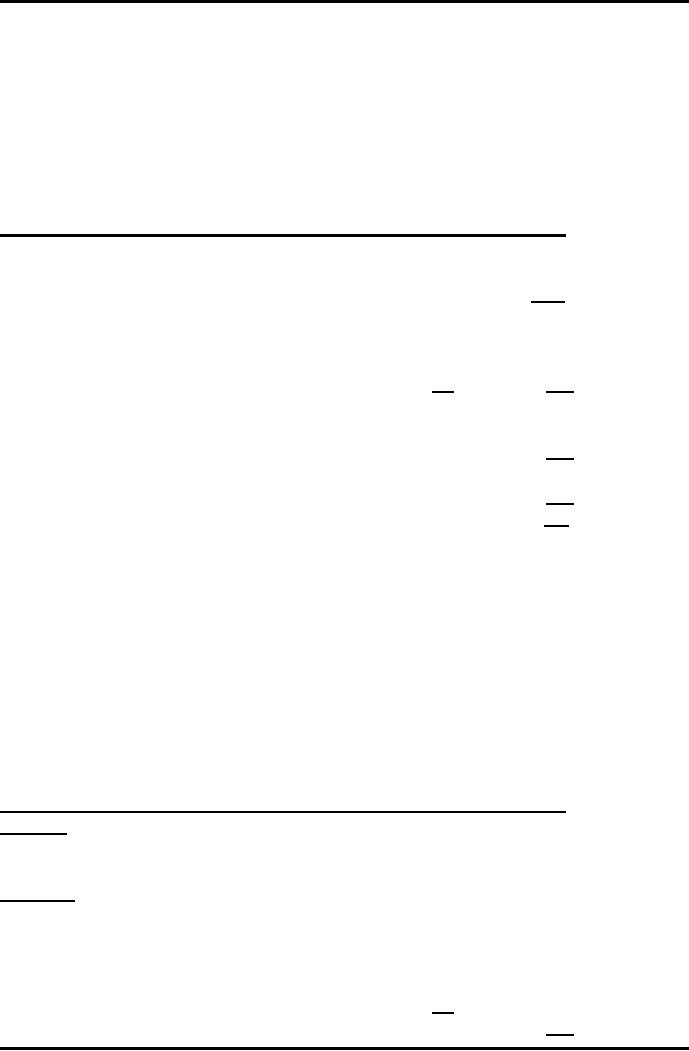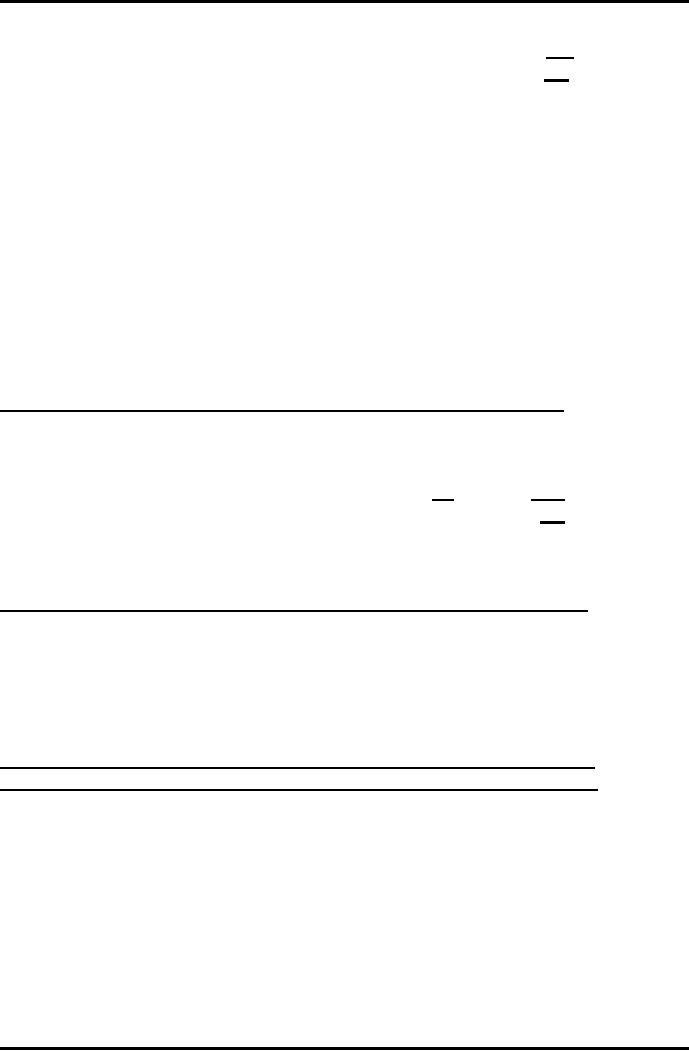 |
COMPANY ACCOUNTS 2 |
| << COMPANY ACCOUNTS 1 |
| Problems Solving >> |

Advance
Financial Accounting
(FIN-611)
VU
LESSON
# 21
COMPANY
ACCOUNTS
Components
of financial statements
As
per International Accounting
Standards there are five
components of financial
statements:
1.
Balance
Sheet
2.
Income
Statement
3.
Statement
of Changes in Equity
4.
Cash
Flow Statement
5.
Notes
Here
we will discuss all but cash flow
statement in detail as the
cash flow statement
will be
discussed in separate
chapter.
1)
Balance Sheet
It
has already been discussed
in the preceding section
that balance sheet of an
entity
shows
financial position, which comprises of
resources and source. A very
simple
equation
of balance sheet is:
Assets
= Owners' Equity +
Liabilities.
Where
Assets are the resources and
Owners' Equity and Liabilities
are the sources.
Limited
Liability Company
Balance
Sheet
As on
December 31, 2009
Rs.
Rs.
Assets
(Resources)
Non
Current Assets
Fixed
Assets
Tangible
Assets
***
***
Intangible
Assets
***
Long Term
Investments
***
Long Term
Loans
***
Long Term
Advances, Deposits &
Prepayments
***
***
Current
Assets
***
Current
Liabilities
(***)
***
Capital
Employed
***
97

Advance
Financial Accounting
(FIN-611)
VU
Financed
By (Sources)
Owners'
Equity
Ordinary
Share Capital
***
Reserves
Capital
Reserves
***
Revenue
Reserves
***
***
***
Non
Current Liabilities
Loan
Stocks/Term Finance
Certificates
***
Loan
from financial institutions
***
Finance
lease liability
***
***
Capital
Employed
***
Approved
by Chief Executive and a
Director
Classification
of assets in the balance sheet is on
the base of permanency
order. This is
known as
marshaling. In a company balance
sheet grouping and marshaling is
strictly
followed.
It is clearly presented in the
balances sheet that assets
are broadly
classified
into
Non-Current Assets and Current
Assets. Non-Current Assets
are then grouped
into
fixed and other non-current
assets. Fixed assets are further
classified into fixed
tangible
and fixed intangible
assets.
a)
Fixed Tangible
Assets
These
are the property, plant and
equipment that are held by
the entity a) for
production
or selling of goods or services, b) for
administrative purposes, or c) for
rental
to others. These are
expected to be useful for the
entity for more than
one
accounting
year.
Examples
include:
land & Building, Plant &
Machinery, Furniture & fixtures,
Motor
Vehicles,
Office equipments
etc.
b)
Fixed Intangible
Assets
These
are the identifiable, non
monetary asset in control of
the entity that have
no
physical
existence and are expected to be
useful for the entity for
more than one
accounting
year.
Examples
include:
Trademark, Copy right, Patents,
Designs etc.
c)
Long term
Investment
These
are the investments made by
the company in other
entities for more than
one
accounting
year.
98

Advance
Financial Accounting
(FIN-611)
VU
Examples
include:
Investments in equity instruments or
debt instruments of
other
entities.
d)
Long term
loans
These
are the loans given to
the third parties on long term basis,
receivable after the
expiry
of more than one accounting
year.
e)
Long term advances,
deposits, and
prepayments
These
are the security deposits,
fixed deposits, advances
given to the suppliers
of
assets,
and prepayments on long term
basis.
f)
Current Assets
These
are the assets recoverable and
tradable within the normal operating
cycle of an
entity
that is 12 months after the
balance sheet date in normal
circumstances. Cash and
cash
equivalents are also current
assets.
g)
Current Liabilities
These
are the obligations that
are payable within the normal
operating cycle of an
entity
that is 12 months after the
balance sheet date in normal
circumstances. This
also
include
bank overdraft.
2)
Income Statement
Income
Statement is prepared to know the
financial performance of an entity. In
an
Income
Statement; expenses for the
year are subtracted from the
incomes earned
during
the year. Both incomes and
expenses are measured
according to the
accrual
concept,
whereas, profit are measured
according to the matching
concept.
According
to the IAS 1 Income Statement
can be prepared using
ether:
1.
Function of expenses method,
or
2.
Nature of expenses
method
a)
Function of expenses
method
According
to the functions of expenses
method the expenses are
divided into five
groups
according to their
functions:
� Cost
of sales
� Administrative
� Selling
and marketing
� Financial
� Income
Tax
99

Advance
Financial Accounting
(FIN-611)
VU
Incomes
are also divided into two
groups:
�
Sales
revenue (operating
income)
�
Other
incomes (non-operating
incomes)
Limited
Liability Company
Income
Statement
For
the Year ended December
31, 2006
(Function
of expenses method)
Rs.
Rs.
Sales
revenue
***
Cost
of goods sold
(***)
Gross
profit
***
Operating
expenses
Administrative
expense
***
Selling
& Marketing expenses
***
(***)
Profit
from operations
***
Other
income
***
Financial
expenses
(***)
Profit
before tax
***
Income
tax expense
(***)
Profit
after tax
***
b)
Nature of expense
method
According
to the nature of expense
method all expenses are
aggregated in the
incomes
statement
and are matched with the
total incomes for the year.
Since both incomes
and
expenses
are of different nature
therefore this method of
preparing Income
Statement
is known as
nature of expense
method.
Limited
Liability Company
Income
Statement
For
the Year ended December
31, 2006
(Nature
of expense method)
Rs.
Rs.
Incomes
Sales
revenue
***
Other
incomes
***
***
Expenses
Increase/decrease
in inventory
***
Raw
materials and consumables
***
Employees'
salaries and wages
***
Utility
bills
***
Other
business operation
expenses
***
(***)
Financial
expenses
(***)
100

Advance
Financial Accounting
(FIN-611)
VU
Profit
before tax
***
Income
tax expense
(***)
Profit
after tax
***
3)
Statement of Changes in
Equity
Statement
of changes in equity is prepared to know
the movement in the items
of
owners'
equity. There might be two types of
the statement:
1.
Statement that shows the
movement in the retained
profits only
2.
Statement that shows the
movement in all the items of
owners' equity
Limited
Liability Company
Statement
of changes in equity
For
the year ended December
31, 2006
(Showing
movement in the retained
profits only)
Rs.
Rs.
Retained
profits b/f
***
Profit
after tax
***
Dividend
paid
***
Transfer
to reserves
***
(***)
Retained
profits c/f
***
(Showing
movement in all items of
owners' equity)
Share
Share
Revaluation Named Retained
Total
Capital
Premium Reserve Reserve
Profits
.
Opening
Balance ***
***
***
***
***
***
Fresh
issue of shares
***
***
***
Revaluation
of Assets
***
***
Profit
after tax
***
***
Dividend
paid
(***)
(***)
Transfer
to named reserves
***
(***)
_
Bonus
Share
***
(***)
(***)
(***)
-_
Totals
***
***
***
***
***
***
.
101
Table of Contents:
- ACCOUNTING FOR INCOMPLETE RECORDS
- PRACTICING ACCOUNTING FOR INCOMPLETE RECORDS
- CONVERSION OF SINGLE ENTRY IN DOUBLE ENTRY ACCOUNTING SYSTEM
- SINGLE ENTRY CALCULATION OF MISSING INFORMATION
- SINGLE ENTRY CALCULATION OF MARKUP AND MARGIN
- ACCOUNTING SYSTEM IN NON-PROFIT ORGANIZATIONS
- NON-PROFIT ORGANIZATIONS
- PREPARATION OF FINANCIAL STATEMENTS OF NON-PROFIT ORGANIZATIONS FROM INCOMPLETE RECORDS
- DEPARTMENTAL ACCOUNTS 1
- DEPARTMENTAL ACCOUNTS 2
- BRANCH ACCOUNTING SYSTEMS
- BRANCH ACCOUNTING
- BRANCH ACCOUNTING - STOCK AND DEBTOR SYSTEM
- STOCK AND DEBTORS SYSTEM
- INDEPENDENT BRANCH
- BRANCH ACCOUNTING 1
- BRANCH ACCOUNTING 2
- ESSENTIALS OF PARTNERSHIP
- Partnership Accounts Changes in partnership firm
- COMPANY ACCOUNTS 1
- COMPANY ACCOUNTS 2
- Problems Solving
- COMPANY ACCOUNTS
- RETURNS ON FINANCIAL SOURCES
- IASB’S FRAMEWORK
- ELEMENTS OF FINANCIAL STATEMENTS
- EVENTS AFTER THE BALANCE SHEET DATE
- PROVISIONS, CONTINGENT LIABILITIES AND CONTINGENT ASSETS
- ACCOUNTING POLICIES, CHANGES IN ACCOUNTING ESTIMATES AND ERRORS 1
- ACCOUNTING POLICIES, CHANGES IN ACCOUNTING ESTIMATES AND ERRORS 2
- BORROWING COST
- EXCESS OF THE CARRYING AMOUNT OF THE QUALIFYING ASSET OVER RECOVERABLE AMOUNT
- EARNINGS PER SHARE
- Earnings per Share
- DILUTED EARNINGS PER SHARE
- GROUP ACCOUNTS
- Pre-acquisition Reserves
- GROUP ACCOUNTS: Minority Interest
- GROUP ACCOUNTS: Inter Company Trading (P to S)
- GROUP ACCOUNTS: Fair Value Adjustments
- GROUP ACCOUNTS: Pre-acquistion Profits, Dividends
- GROUP ACCOUNTS: Profit & Loss
- GROUP ACCOUNTS: Minority Interest, Inter Co.
- GROUP ACCOUNTS: Inter Co. Trading (when there is unrealized profit)
- Comprehensive Workings in Group Accounts Consolidated Balance Sheet